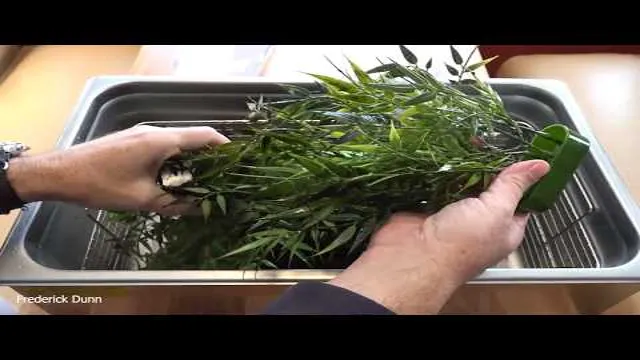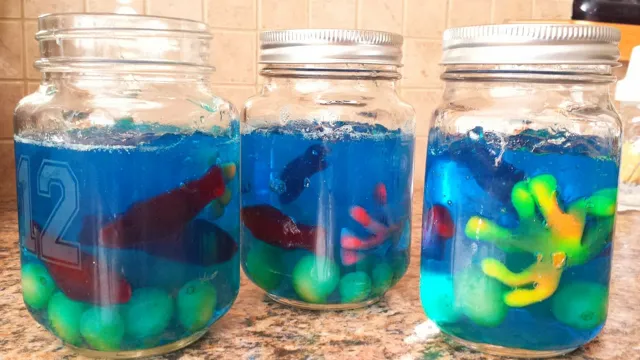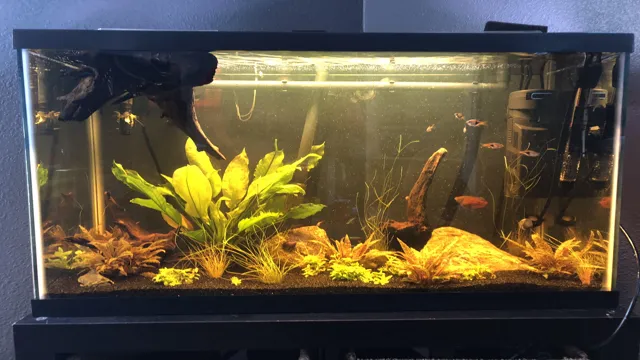How to Know If Aquarium Stocking Level is Safe for Your Fish: A Comprehensive Guide

Are you thinking about getting an aquarium but don’t know how many fish you can keep? Determining the stocking level of your aquarium is a crucial aspect of creating a healthy and thriving aquatic environment. Overstocking your tank can result in poor water quality, stress on your fish, and even death. In contrast, understocking can leave your aquarium feeling empty and unbalanced.
So, how can you determine the right stocking level for your aquarium? Think of it like a game of Tetris, where each fish is a block that needs to fit into the puzzle. By considering factors such as the size of your tank, the specific needs of the fish species you want to keep, and the compatibility of different fish, you can piece together the perfect aquatic ecosystem. So, grab your pen and paper, and let’s dive in!
Understanding the Importance of Stocking Levels
Knowing the ideal stocking level for your aquarium is crucial in maintaining a healthy and thriving aquatic environment. Overstocking can cause stress to your fish, leading to a weakened immune system and increased susceptibility to diseases. On the other hand, understocking can cause your fish to feel insecure and territorial, leading to hostile behavior towards other fish or even self-damaging activities.
To know if your aquarium is at the right stocking level, ensure that you have enough surface area for oxygen exchange, good filtration, and adequate water changes. Also, check the compatibility of your fish to prevent any aggression or territorial behavior. Remember, a balanced stocking level not only ensures the health and well-being of your fish but also creates a beautiful and peaceful aquatic display.
What is an Aquarium Stocking Level?
An aquarium stocking level refers to the number of fish and other aquatic creatures in an aquarium, relative to the volume of water and the tank’s filtration system. Understanding the importance of stocking levels is crucial for maintaining a healthy and thriving aquatic environment. It’s not just about adding as many fish as possible to a tank, but rather about creating a balanced ecosystem that can support life.
Overcrowding can lead to poor water quality, insufficient oxygen and nutrient supply, and increased stress on the inhabitants. On the other hand, understocking can make the aquarium look empty and may even lead to boredom and aggression among the fish. A good rule of thumb is to allow for one inch of fish per gallon of water, taking into account the adult size of the fish and their compatibility with other tank mates.
By carefully selecting and monitoring the stocking levels, aquarium hobbyists can enjoy a beautiful and sustainable aquatic display.

Why is it Important to Keep Stocking Levels in Check?
Keeping stocking levels in check is crucial for any business that wants to succeed in the long run. Without this, businesses might have to face various challenges such as overstocking, understocking, increased costs, reduced profits, and poor customer service. Overstocking can lead to over-investment in inventory, increased storage costs, and even losses if the product becomes obsolete or expires.
On the other hand, understocking can cause delays in fulfilling customer orders and loss of potential revenue. Therefore, it is essential to keep track of inventory levels, demand patterns, and supply chain disruptions to avoid any losses. To achieve this, businesses can adopt various inventory management techniques, such as Just-In-Time, Minimum Order Quantity, and Economic Order Quantity.
By keeping stocking levels in check, businesses can ensure that they have the right product, at the right time, and at the right place, to meet customer demand, reduce costs, and maximize profits.
What Happens When Your Aquarium is Overstocked?
When it comes to keeping an aquarium, understanding the importance of stocking levels is crucial. Overstocking your aquarium can lead to a variety of problems, such as poor water quality, stress in fish, and even death. It’s important to research the specific needs of each type of fish you plan to keep and determine the appropriate number of fish for the size of your tank.
Keeping a balanced and healthy environment for your aquatic pets is key to their happiness and longevity. Don’t let the temptation of adding more fish than your aquarium can handle lead to a harmful situation. Remember, more is not always better when it comes to aquarium stocking levels.
Calculating Your Aquarium Stocking Level
If you’re a fish aquarium hobbyist or novice, determining your aquarium’s stocking level is a critical step in ensuring your fish’s health and happiness. A lot goes into calculating the proper stocking level, including the size of your tank, filtration system, and the type and size of fish you want to keep. Overcrowding your tank can lead to poor water quality, stress for your fish, and worse, illness and death.
A general rule of thumb to follow is to allow one inch of fish per gallon of water. However, some fish require more space or have specific needs, so it’s essential to do your research and calculate your aquarium stocking level accordingly. Remember to consider your fish’s adult size, not their current size, and take into account any plants, decorations, or other tank inhabitants.
By calculating your aquarium stocking level properly, you’ll create a harmonious, thriving environment for your fish, and they’ll reward you with their vibrant, active presence.
Factors to Consider When Calculating Your Stocking Level
When it comes to owning an aquarium, one of the most important things to consider is the stocking level. This refers to the number and type of fish and other living organisms that are present in the aquarium. When calculating your aquarium’s stocking level, there are several factors to consider.
One of the most important factors is the size of your aquarium. A smaller aquarium can only support a limited number of fish, while a larger aquarium can support a larger number of fish. Other important factors to consider include the type of fish you want to keep, their size, and their behavior.
Some fish are more compatible with others, while some may be too aggressive and territorial. It’s also important to consider the filtration system in your aquarium, as a good filtration system is essential for maintaining the health of your fish and other organisms. Ultimately, the goal is to create a balanced ecosystem in your aquarium that supports the needs of all living organisms present.
By considering these factors and others, you can calculate your aquarium’s stocking level and ensure that your aquarium remains healthy and vibrant.
The One Inch of Fish Per Gallon Rule
If you’re interested in setting up an aquarium, it’s important to keep track of the number of fish you’re adding to ensure their continued health and well-being. That’s where the one inch of fish per gallon rule comes into play. This rule simply means adding one inch of fish for every gallon of water in your aquarium.
However, it’s important to note that this rule applies to small, community fish rather than larger or more aggressive species. To calculate your aquarium stocking level, begin by measuring the length of your aquarium in inches and calculate the volume in gallons by multiplying the length, height, and width and dividing by 23 Once you have your total volume, you can decide on the number and size of fish you’d like to add while keeping the one inch per gallon rule in mind.
Remember, overstocking your aquarium can lead to poor water quality and stress for your fish, so it’s important to keep a close eye on your stocking levels.
Other Tank Measurements to Keep in Mind
When it comes to successfully keeping fish in an aquarium, understanding your stocking level is crucial. This means calculating how many fish can safely and comfortably live in your tank based on its size and filtration system. In addition to measuring the physical dimensions of your tank (length, width, and height), you also need to consider other measurements.
For example, the surface area of your tank is important because it affects the amount of oxygen exchange that can occur. The pH level, temperature, and water hardness are also important factors to keep in mind when selecting fish that will thrive in your tank. Properly calculating your aquarium stocking level will help ensure happy and healthy fish.
Factoring in Biological Filtration
When it comes to calculating the stocking level of your aquarium, it’s important to factor in biological filtration. After all, the amount and type of aquatic life you can keep is determined by the amount of beneficial bacteria present in your tank. These bacteria break down harmful waste products produced by fish and other organisms, and their population is directly tied to how much ammonia and nitrite can be processed at any given time.
To calculate your aquarium’s stocking level, you’ll need to consider the available surface area for bacteria growth, the compatibility of different species, and the size of your aquarium. By keeping a close eye on your tank’s biological filtration, you can avoid overloading the system and ensure a healthy environment for your aquatic pets. Remember, a well-balanced aquarium also means a happier and more vibrant display!
Monitoring Your Aquarium Stocking Level
If you’re a new aquarist or simply need a refresher, it’s important to know how to monitor your aquarium’s stocking level. Overcrowding your fish tank can lead to several issues, including poor water quality, stunted growth, and increased aggression among fish. The general rule of thumb is to allow 1 inch of fish per 1 gallon of water, but this can vary depending on the species of fish and their activity level.
To determine if you’ve reached your aquarium’s maximum capacity, calculate the total length of your fish (excluding tail fin) and divide by the number of gallons in your tank. Additionally, keeping track of your tank’s water parameters and observing your fish’s behavior can also indicate if your stocking level is too high. Provide adequate filtration and maintain regular water changes to ensure a healthy and balanced environment for your aquatic pets.
Signs Your Tank May Be Overstocked
As aquarium owners, we all want to provide the best living condition for our fish. However, sometimes it can be easy to get carried away in adding more fish to your tank without considering the consequences of overstocking. One sign that your tank may be overstocked is if you notice excessive waste buildup and poor water quality, which can lead to harmful toxins affecting your fish’s health.
Additionally, overcrowding can also lead to territorial disputes and aggression among fish species, causing undue stress. A good rule of thumb is to follow the “one inch of fish per gallon of water” guideline to ensure you are not overstocking your tank. Remember, a responsible approach to managing your aquarium will ultimately benefit your fish’s well-being and preserve the beauty of your aquatic ecosystem for years to come.
Best Practices for Keeping an Eye on Your Stocking Level
Maintaining the correct stocking level is crucial for keeping your aquarium healthy and thriving. It’s essential to keep an eye on your aquarium’s population and make necessary adjustments. Too many fish in one tank can lead to overcrowding and poor water quality, while too few fish can produce an unstable ecosystem.
One of the best practices to keep your stocking level in check is to use a fish calculator that takes into account the size of your tank and the needs of your fish. Monitoring the feeding habits of your fish can also provide insight into the overall health of your aquarium. Be observant of any signs of stress or disease and quarantine sick fish to prevent the spread of illness to other tank inhabitants.
By staying vigilant and proactive, you can maintain a healthy and balanced aquarium ecosystem that will thrive for years to come.
Using Technology to Help Monitor Your Tank
Monitoring Your Aquarium Stocking Level If you’re an aquarium enthusiast, then you know the importance of stocking levels for your aquatic pets. Overcrowding your tank can lead to stressed fish, increased mortality rates, and even disease outbreaks. To ensure that your tank is not overstocked, you can use technology to monitor the stocking level.
There are a variety of tools available such as digital monitors, sensors, and mobile applications. These tools can help you keep accurate track of the population of your aquarium, ensuring that you maintain an optimal stocking level. With technology, you can set up alerts to notify you when your stocking level is nearing its limit and make adjustments accordingly.
It’s essential to keep your aquarium healthy to create a thriving ecosystem, and monitoring your stocking levels will enable you to do just that. Using technology also takes some of the guesswork out of the process, helping to simplify and streamline the task of keeping aquariums. Remember, a healthy aquarium is a happy aquarium, and keeping an optimal stocking level is a critical step in ensuring that happens!
Conclusion
In conclusion, determining the appropriate aquarium stocking level is crucial for the health and well-being of your aquatic pets. As a clever rule of thumb, think of your aquarium as a busy city where everybody needs space to live and move around. If your fish seem stressed or there is an abundance of waste, it may be time to re-evaluate your population density.
Remember, finding the right balance is key – too many fish and you risk overcrowding, but too few fish can lead to loneliness and behavioral issues. So, keep an eye on your fish’s behavior and keep your “city” running smoothly with a harmonious population. Happy fishkeeping!”
FAQs
What is aquarium stocking level?
Aquarium stocking level refers to the number and size of fish or aquatic animals that can be housed in an aquarium based on its size and filtration capacity.
How can I calculate the proper stocking level for my aquarium?
The general rule of thumb is to have no more than 1 inch of fish per gallon of water in the aquarium. However, this can vary depending on the type of fish you have and their individual needs. It’s important to research the specific requirements for each type of fish.
What happens if I overstock my aquarium?
Overstocking an aquarium can lead to poor water quality, which can be harmful to fish and other aquatic animals. It can also increase the risk of disease and stress for the fish.
How can I tell if my aquarium is overstocked?
Signs of an overstocked aquarium can include cloudy or discolored water, high levels of ammonia or nitrate, aggressive behavior among fish, and difficulty maintaining consistent water parameters.
What should I do if I realize I have overstocked my aquarium?
If you realize your aquarium is overstocked, it’s important to reduce the number of fish or aquatic animals in the tank. You can also increase filtration and perform more frequent water changes to improve water quality.
Can I add more fish to my already stocked aquarium?
If your aquarium is already stocked to capacity, it’s not recommended to add more fish. Doing so can lead to overstocking and poor water quality.
Are there any other factors that affect aquarium stocking level?
Yes, other factors that affect aquarium stocking level include the type and size of fish, their growth rate, and their feeding habits. It’s important to research each type of fish and their specific requirements before adding them to your aquarium.






